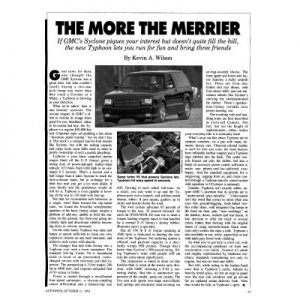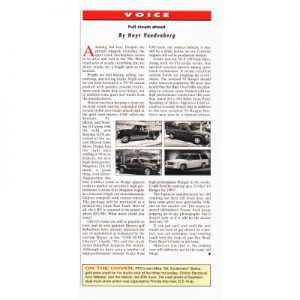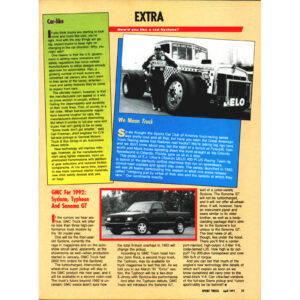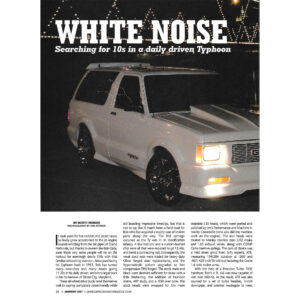Turbo and High Tech Performance
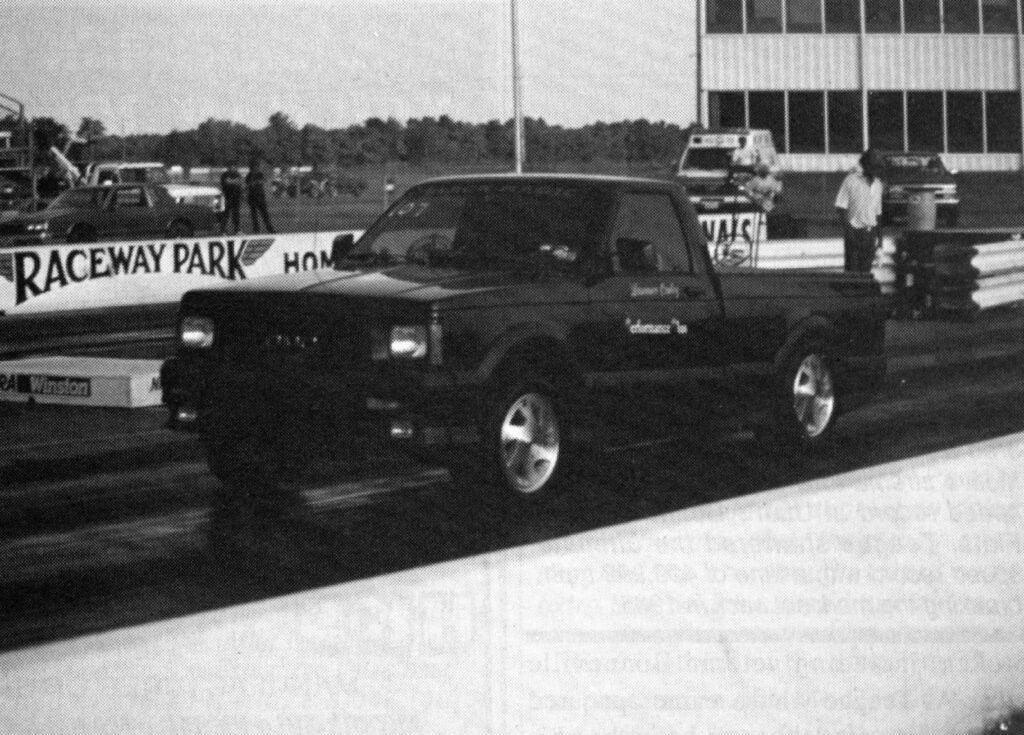
With the introduction of the Syclone a year ago and the Typhoon this year, GMC has sent a message to buyers that they are in the performance business. Now that enough time has passed for some of the aftermarket shops to get some runs under their belts, we have compiled some information on how GM did with the Syclone and Typhoon and how they can be made even better.
As a publication that for years has “touted” engines like this, we love to see the comparison features other publications have done with the Syclone, practically attributing its power to some hidden magic. The magic of course is that little snail looking thing hooked to the exhaust that we named our magazine after. As we have proclaimed for years, with Buick’s solid approval, give us a decent three to four liter V-6, add some turbo boost and correct fuel management and we will show you performance with reasonable fuel mileage.
The list of performance products available for the Syclone/Typhoon is rapidly growing, so we are going to give you a brief overview of what to expect in the coming year. Since there is a lot of ground to cover and several companies that make aftermarket products for this engine, we will try to be as brief as possible on each subject.
STOCK PERFORMANCE
Out of the box, the Syclone is no slouch–but then if it was, who would really care about trying to make it go faster? You can expect mid l3’s al 100 mph driving off the lot, depending on altitude and temperature. That’s enough to beat most everything coming off the showroom floor today. Rated at 280-horsepower, there is plenty more on tap, but use caution.
We are starting to see low 12-second times with bolt-ons, and low 11-sccond times with minor engine work. With a little more time, I I-second street machines and I 0-second race cars–excuse me-trucks, will be a reality.
As we noted in our last issue when reviewing the new Typhoon (which, in our opinion, is more practical than the Syclone although 200 pounds heavier), these vehicles can really handle. All-wheel drive is, of course, one of the keys to the handling. Combined with the power, it is also the key to the low four second zero to 60 times we are starting lo see.
No, the Syclone won’t compete with a tricked-up 300ZX Turbo on the top-end, but how many freeways have 200 mph speed limits? If you put them together for the quarter mile or even a little longer and it would be a fun race.
We have been keeping close contact with the shops that specialize in Buick and now Syclone performance to try to separate the facts from the fantasies. We have found that the rules are almost the same, but there are a few exceptions–so pay heed.
The following recommendations are made in order of importance, based on a compilation of the reports from these companies’ drag strip testing, along with a full day on the dyno with a Syclone engine at Duttweiler Performance and a foot thick stack of print-outs from the on-board data system used by Kenne-Bell to monitor virtually every part of the Syclone under different duty cycles.
FUEL PRESSURE: A KEY PLAYER
One of the first things to address before getting carried away with chips, turbos, more boost pressure or virtually anything–except perhaps an exhaust system– is the fuel pressure regulator. There are several quality adjustable units available. In our testing we utilized the Kenne-Bell billet racing unit. Stock fuel pressure is 40 psi at idle and 60 psi at WOT. With an adjustable regulator you can set the pressure at 50 psi idle and 70 psi at WOT.
While this will only give you modest gains like better cold start and elimination of part throttle lean surge on a stock engine, as you climb the performance ladder it could mean survival.
WATCH FOR DETONATION
The Syclone is not as forgiving as a Buick with regards to detonation, which is one of the reasons we made the first recommendation. There are several knock detectors available, put one on your list.
IMPROVED INTERCOOLER
The stock air/water intercooler is marginal under racing conditions, and several companies now offer upgrades. On the engine dyno, the stock intercooler with a garden hose running 65 degree water through it al full speed was doing halfway decent. So just adding cooling capacity could be one of the answers. Don’t forget a bottle of Red Line “Water Wetter;” it’s good for about 10-degrees.
TURBOCHARGER
The stock turbo runs out of breath at about 3,800 rpm. There are several upgrade packages, mostly based on the Mitsubishi line (the company that supplies the OEM turbo). We saw some big (over 60) horsepower numbers attached to the upgrade Turbo City was using, but when the engine went back in the vehicle, it lost some bottom-end.
You have two choices here: go to a higher stall converter, or check out one of the hybrid turbos now under development that will incorporate a slightly larger (than stock) compressor with a stock but slightly opened up turbine housing. We had a chance to re-test the Turbo City truck with a prototype of this combination and after several low-four second passes in the zero-to 60 sprint, we feel that with the ultimate “combination turbo,” a torque converter and a shift kit, mid threes could be attainable.
FUEL PUMP
About the time you bolt on that bigger turbo, you are going to need even more fuel. Think about an additional fuel pump and some larger injectors. A word of caution here is that the factory ECU was designed to drive 14 ohm injectors; most of the larger ones currently offered are in the two ohm range. These could fry a stock ECU. We understand that some larger capacity 14 ohm injectors in the 35-40 lb range will be hitting the market by mid-fall. Keep your eyes peeled, or think about changing to an aftermarket ECU that can support the additional amperage draw of the two ohm injectors. While it is possible to use the lower impedance injectors for a short time, we have seen enough problems to note it is not advisable unless modifications to the ECU are made to compensate for the higher amperage draw.
CHIPS
We have put chips down the list a few items because most of the ones that give added performance do so by raising the boost pressure. If you don’t prepare the fuel system before going to higher boost pressures you are looking for trouble. As we have mentioned before in our ‘Turbo Updates’ column, and will cover in the piston section, the factory pistons will work well up to a limit. Depending on a few variables that limit is around 17psi.
If you purchase a chip that will cause the turbo to go over 17 psi and do not add more fuel or use racing gasoline, detonation will wreck your toy.
The programming in the Syclone computer was best described by Ken Duttweiler when he asked if we knew what a Camel was. After the normal guessing, he informed us that a Camel was a horse designed by committee. The Syclone programming, it seems, was also designed by committee–with every different safeguard that each person on the committee could think of thrown in for good measure.
YOUR RIGHT FOOT
We mentioned that there are several knock meters, and even knock retard systems available that will work with the Syclone, but remember the most important knock retard device is connected to yo!.:r right ankle. If you hear knocking under full throttle load, lift your foot or reach for your wallet.
CAM & VALVE SPRINGS
Here again, there is plenty of room for improvement. On the dyno, even the entry level unit from Crane produced good results with no loss of idle quality. The valve springs are about 50 pounds light, which gives less internal friction and improved economy on the street. They can also act as an unwanted built-in rev-limiter when you are going for it. Stock Z-28 springs work well.
PISTONS
While the factory hyperutectic pistons are actually a fairly rugged unit and will endure quite a bit of punishment, they become suspect at over 17 psi, or in the face of detonation. Fortunately, since the Vortech V-6 is really a 5.7-liter (350) Chevy V-8 with two missing cylinders, the TRW forged turbo pistons (2441-F) are readily available. We understand Kenne Bell stocks them in volume, drilled and ready for installation into the V-6. Since the dish on the TRW’s is 21cc vs the stock 18.2 cc, they will lower compression slightly, permitting more boost.
In addition to the major items discussed, there are a myriad of other components currently available from the shops included in the source listing.
The Turbo City truck was used by Suspension Techniques develop some products for the Syclone and just a slight two inch lowering coupled to heavier front and rear sway bars made this one fine handling machine. Both companies are continuing work on other components and we should see some shocks available by the time this feature hits the stands.
The stock shocks are not really that bad, but with the lowering, a slightly shorter shock is needed to prevent bottoming on a hard bounce.
At the time of this writing, the new Typhoon is just going on sale. With its increased passenger room, we expect to see not only increased sales for GMC, but the line-up of aftermarket components continue to increase.
While many of the products we have discussed here are still only legal for racing use, we understand that many of the manufacturers are going to have emissions legal versions of these products for legal street use in all 50 stales shortly.
Our next question is now that GM has an all-wheel drive platform that handles and performs, what else are they going to think about putting it under. How about an AWD Turbo 4.3 Camaro, with Independent Rear Suspension?

